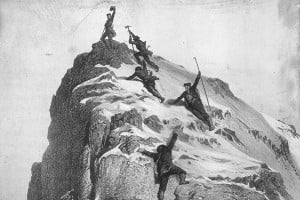
Nestled on a hillside at the foot of Mont Blanc is an unlikely academic institution where some of the finest minds in physics - including 50 Nobel Prize winners and Stephen Hawking - have exercised their thoughts and theorems, interspersed with some high-altitude antics. Natalie Berry explores the school's history and the connection between physics and mountaineering.
The lightbulb moment came in 1950 while brushing her teeth early one morning; the one after the night before, when she had turned down US physicist Bryce DeWitt's marriage proposal. Cécile Morette put down her toothbrush and picked up the phone. "Does your offer still hold? Actually, I'd very much like to marry you, if you'd first let me set up a summer school in France!"
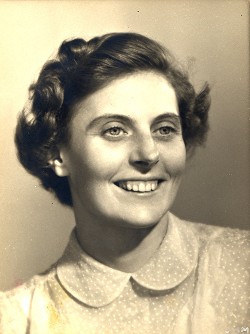
For Morette, exporting her talent for physics across the Atlantic to the United States upon marriage would be a disservice to her native France, where scientific and intellectual progress had been hampered by World War II—an issue close to her heart. 'I wanted to help France and other European countries to start up again in physics by providing a solid introduction to those students who had not had the opportunity to go abroad,' Morette explained in a letter. Planting a seed in French soil to be tended each summer while working together in the United States was the solution. The wedding of Cécile Morette to Bryce DeWitt took place in May 1951, shortly before Morette's condition of marriage was fulfilled: the founding of the École de Physique des Houches, or the Les Houches School of Physics near Chamonix, France.
However, Morette had some convincing to do. To earn the support of male colleagues for the school, she tricked them into believing that the proposal was their own. She would describe her plans and then phone the following week to exclaim, "Oh, that idea you told me about was great!" In an attempt to pin down an influential government minister to talk funding for the school, Morette devised a cunning plan. She entered the government building and removed her jacket and hat, pretending to be a secretary. When the minister's secretary went for lunch, Morette boldly entered his office demanding an appointment, which she duly received - along with the necessary funds. 'I was an intellectual geisha!' she would later say of her youthful exuberance and trickery.
Born in Paris in 1922, Morette grew up in Normandy and had designs on becoming a surgeon, but during World War II, the choice of medical schools was limited. Instead, her scientific aptitude found its place in mathematics, physics and chemistry, which she studied at the University of Caen, graduating in 1943. While she was carrying out further studies in Paris during Nazi occupation, Morette's mother, sister and grandmother were killed during an Allied bombing of Caen in support of the D-Day landings. Her family and home destroyed at just 21, Morette was forced - like many of her generation - to grow up fast. 'I now felt in charge of my family,' she later said, 'so I thought I had better get a job.'
Although small in stature, Morette's tenacity and sharp intellect propelled her to scientific acclaim at a time when women in science were anomalous, earning her scholarships to US institutions including the Institute for Advanced Study in Princeton in 1948, where she would meet DeWitt but still find her thoughts drifting back to France. Her concept of a summer school coincided with other efforts to globalise scientific research at the time, such as the Fulbright program, founded in 1946, which continues to put foreign scientists and young researchers in contact with one another to this day. But Morette was dissatisfied with the state of teaching of theoretical physics - her specialism. Writing in a proposal for the school, she outlined the purpose of the courses:
'The teaching of theoretical physics is, in general, insufficient. In these conditions, it would be a good idea to provide French and foreign students and young researchers with a basic education at their disposal to tackle the problems of modern theoretical physics. [...] The summer period allows us to take advantage of visiting foreign professors to France who will agree to contribute to the school, while enjoying a stay in a picturesque region. [...] Such a school in Europe would also contribute scientifically to international co-operation and French prestige.' - Cécile Morette, 1950, Physique théorique. Projet de création d'une école d'été.
With the concept in mind and the funding in her pocket, all that remained was finding a location for the school. Morette knew that she couldn't afford to pay lecturers handsomely, so - putting her shrewdness into practice once more - she opted to situate her school in an unusual environment to add value to the experience. The high mountain Alpine laboratories dedicated to the study of cosmic rays, such as those situated in L'Argentière, at the Aiguille du Midi and the Pic du Midi, were of interest but subsequently discounted due to high costs, social impracticalities and external distractions.
Ultimately, a cluster of chalets owned by a family friend was the chosen site at an altitude of 1,150 metres in Les Houches, six miles from Chamonix in the heart of the French Alps. Urban surroundings were swapped for the jagged peaks of the Mont Blanc Massif, concrete campuses replaced with wooden mazots, and roaming students mingled with herds of grazing cattle. Recognising the alpine setting as an attractive alternative for lecturers and students alike, Morette was forging the path to creating a unique and influential academic institution.
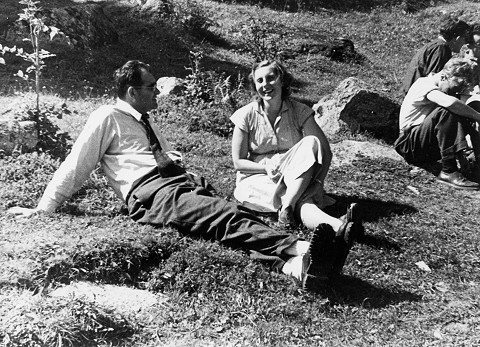
Initially, however, the school wasn't quite as idyllic as one might expect. In 1951, the first summer school on quantum mechanics was held in an isolated, rustic farmhouse surrounded by mazots (wooden huts) on a 40-hectare property. Some students slept on piles of straw. Lectures were accompanied by a cacophony of cow bells and the associated odours, channelling a 'welcoming mountain hut' ambiance, as a student would later fondly recall. The narrow road which winds its way up to the school, Côte des Chavants, soon became renamed as Côte des Savants in reference to the intelligent scientific minds that the growing institution began to attract.
This nascent summer school received 200 applications for just 35 places. The ball had started rolling, and Morette's project was gaining momentum - and money. The École became part of the University of Grenoble and by the early '60s had expanded to include surrounding chalets and outbuildings providing further accomodation, classrooms, offices, a restaurant and a library.
British-born American theoretical physicist and mathematician, Freeman Dyson, recognised the school's contribution towards easing Europe's strained international relations. 'In the year 1954 when I was at Les Houches, all the young people were intoxicated with a feeling of joie de vivre. We were Europeans, we had survived the war and the dismal years of impoverishment that followed the war, and now we finally saw Europe risen from the ashes and rebuilding itself. Les Houches was a visible symbol of the rebuilding. The rebuilding was spiritual as well as physical. We knew we were lucky to be a part of it,' he wrote in a 2001 tribute to Morette.
The success of the school and its formative influence on participating students was far-reaching. Since 1971, all physicists elected ́to the prestigious Collège de France have been former pupils of the École des Houches, and 51 Nobel Prizes can be traced back to the school. Former student Jürg Fröhlich pondered: 'Might it be that, under those primitive conditions, people were less easily distracted and therefore working more intensely?' Distractions did occur, however, in the form of mountain jaunts.
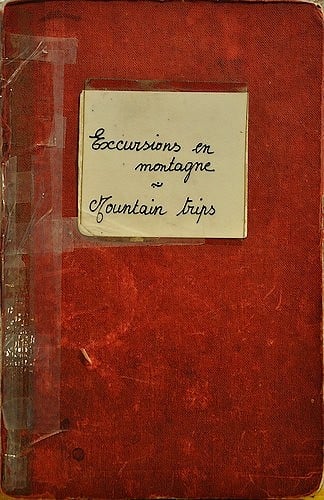
***
Despite its setting in the heart of the Alps, the summer school has attracted relatively few experienced climbers and mountaineers over the years, according to John Cardy, a British-American theoretical physicist at the University of California and accomplished climber, who gave several lectures at the school. 'I wouldn't say there was a particularly strong correlation between active climber physicists and those attending the school,' he says. 'I think this is largely because one is expected to attend lectures five days a week leaving only the weekends free. I used to find it highly frustrating to see this view all week and then inevitably get bad weather most weekends!'
On the other hand, one former student remarked in a letter that in 1953, 'all the attendees seem to have been Sherpas that year.' One of those Sherpas was Nobel Prize winner and Dolomites amateur Enrico Fermi, who was teaching at the summer session. Daniele Amati reminisced in a letter: 'While walking on the flat Mer de Glace I was happily jumping over crevasses despite Fermi saying "Piano, Amati, piano" [slow, Amati, slow]. In fact, on the rather steep slope that then leads towards the refuge it took me (at 23 years of age) two hours to climb what Fermi (at 53) did in one.'
For the uninitiated, however, Mont Blanc and its satellite peaks held a magnetic appeal. When Cardy did go climbing with students from the school, it was with relative novices up low-level rock climbs. Undeterred by poor weather forecasts, some novices attempted more hazardous expeditions. 'Of course they all wanted to do one thing,' Cardy explains, 'go up Mont Blanc. I was always concerned by their lack of experience, but all I could do was offer advice.' Fortunately there were few serious incidents, but some close calls during Cardy's visits. 'One case I remember was in 1988 when Sasha Polyakov went up Mont Blanc alone in a pair of trainers! More recently when I was there a group of four, three of them novices, did the Trois Monts route and were inevitably benighted.'
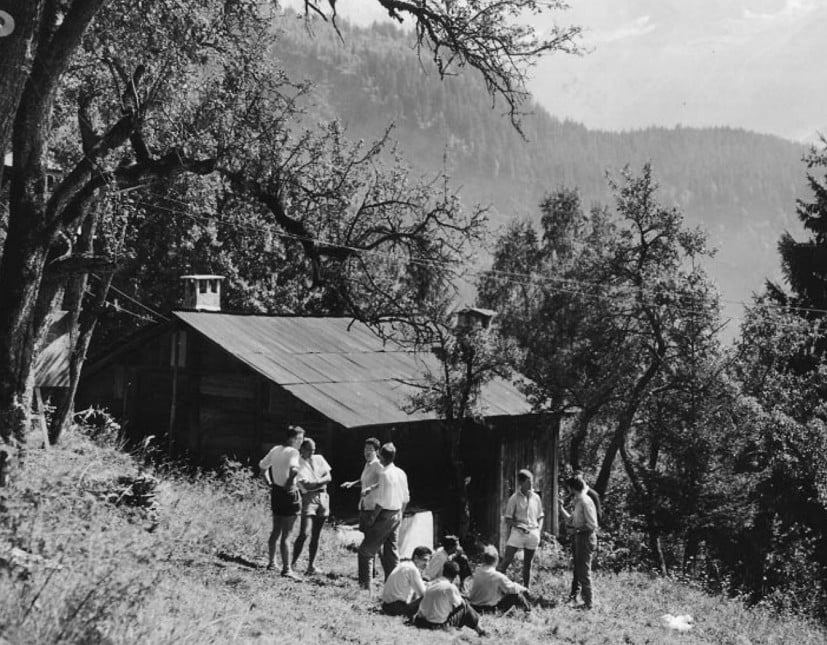
In the school's 50th Anniversary Livre d'Or, a book of memories from former students dedicated to Cécile Morette, multiple gutsy excursions and near-misses are recounted in a mix of French and English from an international haul of reminiscent and reverent students, many of whom now occupy lofty positions in the realm of physics, have won Nobel Prizes or Fields medals, or at least thrived on the genius and energy of others who have while at Les Houches.
One account by Marie-Simone Cassigneul Detoeuf recalled 'some beautiful escapades towards the summits, where a certain future Nobel Prize winner, gripped by vertigo, loudly cried out for his mother.' Another account recalls future Nobel Prize winner Georges Charpak being a 'memorable character' who found a pair of bull horns in a barn and proceeded to wear them on his head and charge around.
Particle physicist André Martin, who spent much of his career working at CERN, shared an equally humorous anecdote about Cassigneul. 'One day, during the 11 a.m. break, the sky finally emerges and we see, amazed, the whole chain of the Aiguilles de Chamonix appear, from the Aiguille du Chardonnet to the Aiguille de Bionnassay. Marie-Simone Cassigneul exclaims: "But I didn't know there were mountains here!"'
Belgian-French mathematical physicist David Ruelle reminisced about character-building extra-curricular climbs. 'I had participated fruitlessly (but with dignity) in an attempt to reach the summit of Mont Blanc. After which we remembered other Alpine failures. You [Cécile] then recalled how Kurt Symanzik had ventured, in t-shirt and trainers I believe, into the avalanche couloir on the way up Mont Blanc. He had slipped and, fortunately, came out of it alive, though a little worse for wear. You had been to see him in the hospital. "And you know what he told me?" you said, "He told me he had no luck!"'
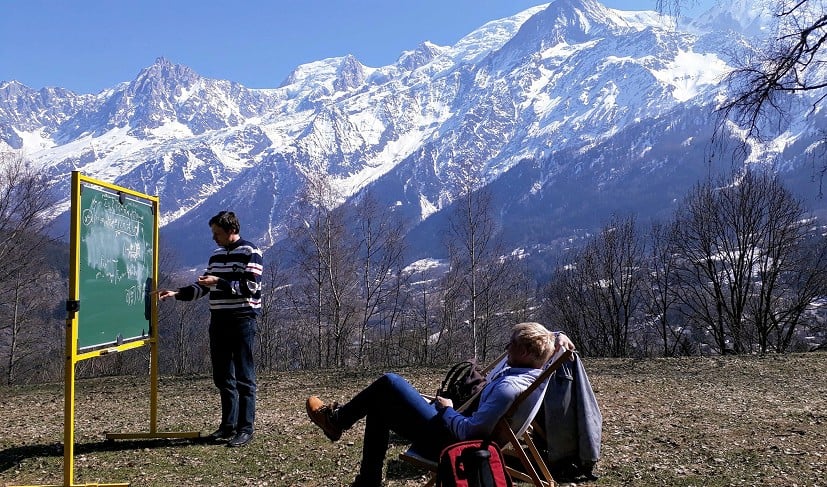
One opportunist climber with the surname Buch landed on his feet in fortuitous circumstances. 'I wanted to rest and go on some climbing holidays, so I called in to Les Houches - one stop before Chamonix - to say hello to Nozières, as I knew he was the director of a session on the n-body problem. Since a place was freed up by a student due to family reasons, I ended up proposing that I take their place. I accepted Philippe and Cécile's offer, beginning my status as a clandestine student.'
Interaction with and an appreciation for the natural landscape caused some physicists to ponder the impact of climate change in the Valley. The late French theoretical physicist, Raymond Stora, wrote in the Livre d'Or in 2001: 'Everything's changing: the Bossons glacier is no longer what it was, safe for cramponing between midday and 4 p.m., and the protective and menacing Bionnassay cornice, will it one day fall down onto the Côté des Chavants, before its time?' 19 years later, in 2020, the massif's glaciers continue to disappear at an alarming rate. French energy physicist Hervé Nifenecker, who was in charge of scientific direction during the 46th summer school, went on to become the founder and president of the French sustainable energy association, Sauvons le Climat, 'Save the Climate.' Nifenecker contributed a poem to the Livre d'Or, skilfully weaving the intricacies of physics problems with a story of ascent:
Les Houches or the ascension of the physicist (translated)
Thick mist which envelops beings and things in its wet quilt
An opaque sail that fogs our spirits and prevents us from seeing the frogs, yet we still hear the quarks
Will we see this hidden mountain one day?
Will we ever see this physicist's grail?
We must wait for the wind to pick up
We must listen to the word of Master Meuleur
We must leave in the darkness which pales
We must learn the obscure concept
In the quivering daybreak the roped team follows the guide Johannis Paulus Plasmaticus
The slope is steep and the horizon obscure
Oh how difficult this confined path is
Out thus by the chiral transition
A hesitant glow encircled by uncertain summits
The beautiful sound of the Pierre d'Or delights the spirit
This silhouette, is it that of the Drus or the Weise peak?
Further still and beyond the Bertsch pass, but yes it's the Mottelson!
But we will still have to face magical valleys and giant modes to reach Monte Carlo!
And beware of the fall that multifragments!
At the refuge how sweet it is to sing led by our cantor Georg, accompanied by Wolfram or Frederic with light fingers
Master Pierre the chronicler may write the story.
Although she was protective of her students, excerpts from the letters suggest that Morette - a keen walker and skier herself - didn't keep them on a short leash; instead, she trusted them to find their own feet in the mountains and take responsibility for themselves. Belgian theoretical physicist Jean Nuyts - another former CERN employee - wrote of his memories of 1961: 'Ginibre and I tried in vain to reach the summit of Mont Blanc. You were very happy when we told you that we had given up. [...] Mr. and Mrs. Naudin did not appreciate that we took their daughter for a day of walking at high altitude. Do you remember your intercessions?'
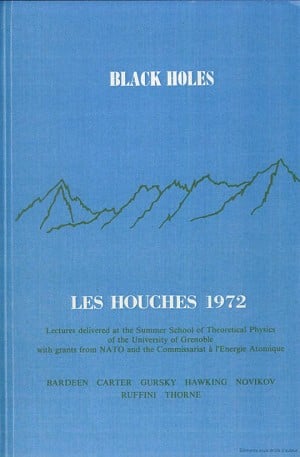
'Against the backdrop of everything, there was always Cécile watching over everything, from the major events to the details, often smiling and very happy, but sometimes a bit more severe,' Nuyts summed up.
During her 22 years of leading the Les Houches school, outside of the summer courses in France, Morette and DeWitt focused on their own scientific research and careers in the USA while raising four daughters. Morette made understated contributions to physics - notably developing Feynman's path integrals from heuristic beginnings into a mathematically robust tool (Feynman diagrams) - but often found herself swimming against the tide of discrimination.
In the 1980s, her grant proposal was declined with a comment that she was 'busy raising children and doing administrative work.' DeWitt was offered a professorship in North Carolina, but Morette lost out to an unwritten nepotism rule which seemed designed to shut out women more than men. Morette was resigned to a lowly lecturer position, and her work was often erroneously attributed to DeWitt on assumption, hence her eventual name change to DeWitt-Morette. In 1972, the couple finally found joint professor positions at the University of Texas, which led to a research project in Mauritania together, directed by Morette, supported by DeWitt, testing Einstein's general relativity predictions during a solar eclipse.
***
Alongside the high-altitude antics, abiding memories for many participants in their letters to Morette include visits to the Pâtisserie des Alpes, encounters with Alpine cows and social evenings around the school's piano. Today, a Livre d'Excursions en Montagne, or 'mountain outings' book remains in the school, filled with stories of hijinks on the high peaks of the Chamonix valley, between sessions of intensive physics.
One group returned from the mountains to an unfortunate surprise. M.T. Béal-Monod wrote in the Livre d'Or: 'One of our mazots was pierced from side to side ... a big rock had hurtled down the slope and passed through it! Our companion was relieved to have interspersed his studious meditations with a climb, more dangerous in theory.' On another occasion in 1966, a mazot burned down and with the firemen unable to start their engine, French astrophysicist Évry Schatzman jumped in and managed to get it started. Already held in high esteem by the group, Schatzman's heroic actions were described by James Lequeux as his 'crowning achievement.'
Another collective emotion was caused by two participants who were benighted in the mountains and had to bivouac. 'The whole school mobilised, Cécile at the head, of course,' Lequeux wrote. 'We were fortunate to have a very good weekend in which we formed several rope teams for Mont Blanc, which remains for me a wonderful memory. On these half days and weekends, when we let off steam on the rocks or the ice, we were able to assume, with a clear mind, the intensive regime of these two months of courses that we all followed eagerly and without fail.'
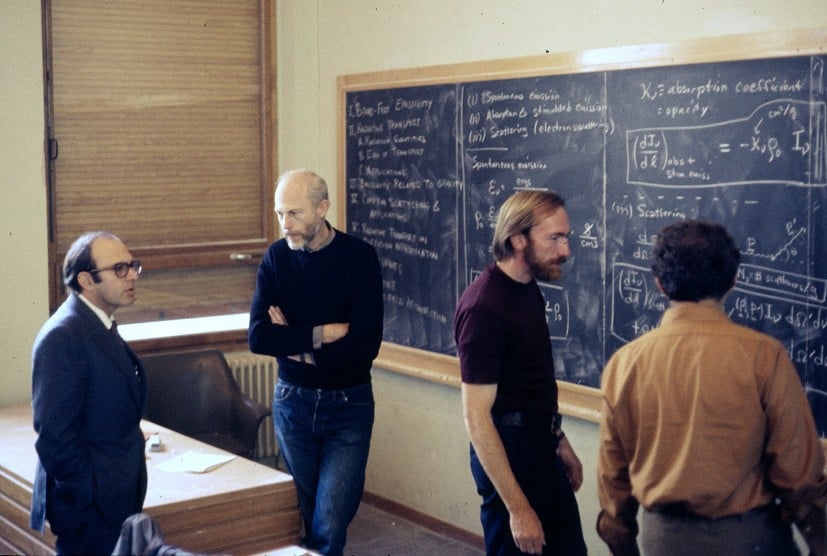
Some students arrived with their families in tow, many of whom became equally enamoured by the school's surroundings - especially the children. 'My son who was then six was most impressed by Les Houches. He has returned at least three times, just to see Mont Blanc, Chamonix, and ride the téléferique. He continues to draw mountains and compares US mountains to the Alps, seeking to live near some mountain range,' US physicist Paul Federbush wrote for the 2001 Livre d'Or.
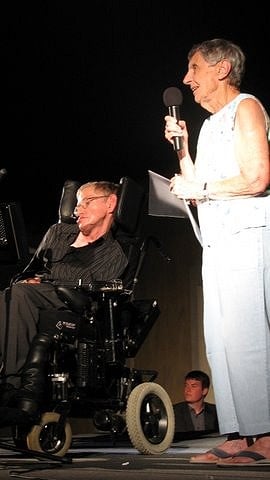
***
For other students, simply being at the foot of the mountains was sufficient inspiration for thought, or a means of finding peace. Perhaps the most famous former professor of the École des Houches - for those outside of the physics sphere, at least - was a certain Stephen Hawking. Jane Hawking wrote emotively about the Hawking family visit to the Les Houches Physics School in 1972, in her book Travelling to Infinity: The True Story Behind the Theory of Everything:
Hawking's time at Les Houches resulted in a significant breakthrough. Black holes were a hot topic in the '70s, and Princeton University graduate student Jacob Bekenstein, who attended the Les Houches session in '72, thought that the second law of thermodynamics should also be applied to black holes. Bekenstein had studied the entropy problem and reached a potential solution thanks to an earlier insight of Hawking's: could the event horizon of a black hole be a measure of entropy?
Outside in the fields between classes at Les Houches, Hawking gathered fellow esteemed lecturers James Bardeen and Brandon Carter and vehemently dismissed Bekenstein's idea in front of him. Upon returning home from the summer school, Hawking ended up proving Bekenstein's theory with mathematics - despite intending to disprove it - resulting in the Bekenstein–Hawking formula, described by the New Scientist as Hawking's 'greatest breakthrough.' 2017 Nobel Prize winner Kip Thorne also attended and taught in multiple sessions at Les Houches, including the 1972 session with Hawking, which likely influenced the famous Thorne-Hawking bet over the existence of black holes, which was made in 1974 and resulted in a subscription to Penthouse magazine for Thorne.
***
The first instrument-laden scientists to grace the slopes of the Chamonix Valley, however, arrived long before the advent of Nobel Prizes or modern physics, and long before the hordes of tourists. Local priests and hunters were the first to explore the natural landscape by foot and sight, before topographers, naturalists, geologists, biologists and physicists from further afield mapped and measured the rocks and glaciers. Mountaineering was a product of mountain exploration: science provided justification for exploration and mountain jaunts, beyond conquering peaks for conquering's sake.
In 1765, the Deluc brothers trudged up Mont Buet near Geneva with a barometer and thermometer in hand, only for them to get lost and for their thermometer to break. Horace-Bénédict de Saussure, the Genevan geologist, meteorologist, physicist and mountaineer, wrote in his work Voyages dans les Alpes: 'Among the mountains of Europe, knowledge of Mont Blanc would most seem to illuminate the true theory of the earth.' De Saussure would never outline his 'true theory', however.
In 1786, he funded the first ascent of Mont Blanc by Jacques Balmat and Michael Gabriel Paccard, offering a cash prize in return for measuring the temperature of boiling water on the summit. One year later, de Saussure achieved the third ascent of Mont Blanc - led by a troupe of local Chamoniards - and wearily conducted observations at the summit. It was 'an epoch-making event', as Claire Engel wrote in A History of Mountaineering in the Alps. 'The vast non-climbing public now became aware of the importance of mountaineering: such efforts were clearly worth while, since a well-known scientist had taken so many risks and endured so many hardships to reach the top of a mountain. There was more to the mountains than an idyllic setting for shepherdesses and kind-hearted chamois-hunters.'
Occasionally, scientific knowledge imparted during excursions would prevent accidents. During a crossing of the glaciated Theodul Pass in Switzerland in the mid-1800s, Scottish physicist James David Forbes reprimanded his guide for toting a large metal-tipped umbrella and pointing it up towards a thunderous sky. Sometimes, experiments did more harm than good.
In 1858, British physicist, glaciologist and pioneering mountaineer by dint of his explorations, John Tyndall, buried a thermometer on Mont Blanc with the intention of recording maximum and minimum temperatures of both the ambient air and the ice core at the summit, the difference between which Tyndall - an early climate scientist - believed was related to glacial movement. But the shovel was left behind. Chamonix guide Auguste Balmat helped to dig with bare hands. One hour later, Balmat calmly said to Tyndall: 'I think my hands are frostbitten.' Determined not to succumb to the pain, Balmat asked his companions to rub snow onto his hands and hit them. 'Hit-hit harder! never fear, harder! Strike harder!' When he returned the next summer to recover the equipment, Balmat couldn't find the thermograph nor the iron bar marking the spot.
So staunch a scientist was Tyndall that he resigned from the Alpine Club when members derided his overly scientific articles for publication in the Alpine Journal. At times, though, even the most punctillious scientists felt the need to tuck away their fountain pen and pack up their instruments to observe in a different manner. Tyndall felt this tension during an ascent of the Weisshorn: 'I opened my notebook to make a few observations, but soon relinquished the attempt. There was something incongruous, if not profane, in alowing the scientific faculty to interfere where silent worship seemed the "reasonable service."' Perhaps it's this balance of scientific rigour and open-minded wanderings among the mountains that the École de Physique seems to have historically struck so perfectly.
By the turn of the Golden Age of mountaineering in 1854, science was no longer the only acknowledged justification for conquest in the European Alps. Emphasis shifted from researching topics for scientific papers to writing subjective accounts of personal stories on lofty climbs. This marked the rise of ascensionnisme, or mountaineering for mountaineering's sake, brought about largely by British mountaineers. As British Golden Age pioneer Charles Hudson wrote, 'We went abroad for recreation: it was pleasure that we sought; and we gave but little thought to useful discovery.' Explorers with no scientific background started bagging peaks with stories of conquest to write home about.
***
Yet the two spheres of interest have orbited together around many prominent individuals over the last century, as George Johnson of The New York Times picked up on in 2001. While physics evolved from physical to metaphysical spaces and mountaineering standards improved, people with an affinity for one seemed to find the other. Numerous names are synonymous with advancements in one or both of these areas, or excelling in one and having a keen interest in the other at least. Keith Brueckner, Raymond Stora, Jeremy Bernstein, William Shockley, Anthony Leggett, Enrico Fermi, Paul Dirac, Henry Way Kendall, Lester Germer and George Irving Bell: to name but a few of the people who have made waves in the world of physics and pioneered - or at least dabbled - in climbing and mountaineering.
On the contrary, some highly accomplished climbers maintain a busy career in physics: Bruce Normand, Raphael Slawinski, Ed Hartouni and Sheffield's own 9a-climbing-astrophysicist Stu Littlefair are weekend warriors who make the most of the freedom between semesters or scientific conferences.
'When I was a student in 1960s in Cambridge, about half the University Mountaineering Club was either mathematicians or physicists,' John Cardy told the Times in 2001. The attraction in both activities, he explained, is 'the simple beauty of the mountains, like that of good physics, the combination of individual effort and teamwork required to reach a goal, the sense of discovery involved in first ascents and in discovering new physics, and the competitive aspect: who will be first to do a climb or write a paper on theory X?'
Cardy's clubmates included Mike Kosterlitz, Gordon MacNair, Geoff Cohen, Bob Barton, Al Rouse and Mick Geddes among others. 'Most of these, apart from Mike and me, did not stay in physics or maths after graduating, however,' Cardy explains today. 'It also has to be said that we never discussed physics or maths while out on the crags!'
Scottish-born physicist and pioneering climber Michael Kosterlitz was one of three recipients of the 2016 Nobel Prize in Physics 'for theoretical discoveries of topological phase transitions and topological phases of matter.' Many climbers quickly made the link between Michael's surname and some classic rock routes in the Italian Alps - including the eponymous Fessura Kosterlitz 6a+ in the Orco Valley. Amongst numerous impressive ascents in the European Alps and in Yosemite and beyond, Michael also made the first repeat of The American Direct (ED1) on Les Drus in the Mont Blanc Massif and initiated the Nuovo Mattino or 'New Morning' movement in Alpinism.
After John Cardy received his PhD, he spent three years working at CERN in Geneva where there were many climber-physicists. 'I mainly climbed with Frank Sacherer, a famous Yosemite climber, and also Joe Weis, another American from Seattle. Sadly they were both killed on the Grandes Jorasses in 1978.' Cardy then moved to Santa Barbara, California as a professor, where it turned out that many of the physics graduate students and postdocs were climbers. 'We would drive to Joshua Tree or Yosemite at weekends, making ascents of the Nose and Half Dome among other things.'
Today, climbers with an interest in science are increasingly gravitating towards glaciology and climate science, likely due to having first-hand experience of the effects of a heating planet on sensitive mountain geographies. Physics terms are also pervasive in modern climbing gear names, as Bruce Normand points out. 'Where would we be without our Pulsars, Quasars and Quarks? There's also Lasers, Vectors and Voltas, Positrons and Neutrinos and Merons!'
***
Aside from Morette's role in founding the Les Houches school and her contributions to physics as a whole, women have undoubtedly been fewer and further between than men in the Venn diagram of physics and climbing. In the 19th Century, women exploring in the mountains generally gravitated towards botany and the social sciences instead. One exception was British mathematical astronomer Margaret Meyer, who was the third President of the Ladies' Alpine Club.
Today, the paradigm is shifting, with more women participating in both science and the outdoors. Melanie Windridge, British plasma physicist, science communicator and mountaineer, has noticed that women in science also seem drawn to adventure. 'Maybe it's some kind of cognitive bias,' she says, 'but I've run into several high-performing women in outdoor adventure who also have scientific PhDs, e.g. Felicity Aston, Lizzy Hawker, Becky Coles, Jasmin Paris and Suzie Imber (a space physicist). Perhaps this indicates something about the mindset of the type of women who go into science and outdoor adventure.'
***
In his book The Cosmic Code, Quantum Physics as the Language of Nature', US climber and physicist Heinz Pagels touched on the relationship between physics and mountaineering, exploring the crossover of both passions. 'Most physicists enjoy the outdoors. They are mushroom gatherers, bird watchers, hikers, amateur mountaineers whose idea of weekend relaxation is to climb a mountain,' Pagels wrote. 'Several physics summer schools and research centers are located in or near mountainous areas. I have not seen such uniform recreational impulses in other professions, an observation which prompts speculation on the connection between the nature of inquiry in physics and mountain climbing [...] The vista physicists have gained from the mountaintop of these unified field theories lets them see back to the beginnings of the universe and the big bang.'
Pagels also wrote about explaining his love for climbing and mountaineering to a disapproving friend:
Heinz Pagels died aged 49 in 1988 in a climbing accident after dislodging a rock and falling down Pyramid Peak, a mountain he had climbed seven times before, in close proximity to the Aspen Center for Physics, where he had spent summers working. Obituary writers drew parallels between this prophetic dream of falling and his untimely death.
In 2019, two notable American names in the world of theoretical physics died in alpine climbing accidents within a day of each other. Steven Gubser, 47, died on the Aiguille du Peigne above Chamonix, and Ann Neson died from a fall while hiking on Iron Cap Mountain in Washington State. 'Over a hundred years ago, a mathematician named Arthur Cayley said that climbing a mountain and proving a theorem gave him the same sort of satisfaction,' the 2001 New York Times article on physics and mountaineering quoted Dr. Gubser as saying when he was at Caltech. 'I think that captures one of the motivations of climbing physicists today.'
In another eerily prophetic sentence, Johnson ended the piece with: 'In science and mountaineering, Dr. Gubser noted, nature is the final arbiter: 'It always seems ready with another surprise, something we couldn't have anticipated.'' Perhaps, by contemplating the fundamental laws of the universe in such depth, these physicists had a fuller appreciation of risk and an acceptance of death; in attempting to grasp at something far larger than their own existence, their own lives appeared insignificant, yet also infinite. As Pagels wrote of Romantic writers in The Cosmic Code: 'A man climbing a mountain became the image of self-conscious intelligence pitted against the eternal indifference of the forces of nature. Compared to these forces of nature, we are nothing save for the will that moves our limbs. Only that will is truly our own.'
***
Bryce DeWitt died in 2004 aged 81 after suffering from pancreatic cancer, while Cécile DeWitt-Morette's long and varied life came to an end in 2017 at the age of 94. The École des Houches continues to flourish, and now hosts year-long physics workshops in addition to the longer summer schools, which often incorporate elements of mathematics, Earth sciences, chemistry, and biology. In 2019, the inaugural Cécile DeWitt-Morette / École de Physique des Houches Prize was awarded by the Académie des Sciences to honour her memory.
De Saussure's hypothesis that Mont Blanc held the key to unlocking some undefined true theory of the earth may not have come to fruition, but in and around a scattering of humble mountain huts in its foothills, some of the world's greatest minds have solved the biggest mysteries of the universe, while having the luxury of space and time to think and the height to see things from a different perspective. French astrophysicist Pierre Lena brought his tribute to the school to a neat conclusion:
'It is said that mathematics rhymes with music, while physicists would necessarily be adventurers of peaks. In mathematics, the pure number and its implacable logic, in physics the anfractuosities, vertigo, structures and innumerable burdens of a harsh, cold or exhilarating nature, nowhere better expressed and perceptible than in the mountains, and especially in this condensed abyss that is the valley of Chamonix.'
UKC would like to thank the following people for their assistance with this article: Marc-Henri Julien, Pierre Verschueren, Bruce Normand, Brigitte Rousset and John Cardy.
References:
- Pierre Verschueren, 'Des savants aux chercheurs: Les sciences physiques comme métier', (France, 1945-1968), Volume I
- Heinz R. Pagels, The Cosmic Code: Quantum Physics as the Language of Nature
- Livre d'Or, École des Houches Cinquantième Anniversaire 1951-2001
- Gilles Modica, 1865: the Golden Age of Mountaineering
- Albert V. Carozzi, 'FORTY YEARS OF THINKING IN FRONT OF THE ALPS: SAUSSURE'S (1796) UNPUBLISHED THEORY OF THE EARTH.' Earth Sciences History, vol. 8, no. 2, 1989, pp. 123–140.
- Claire Engel, A History of Mountaineering in the Alps (1950)
- George Johnson, 'A Passion for Physical Realms, Minute and Massive'



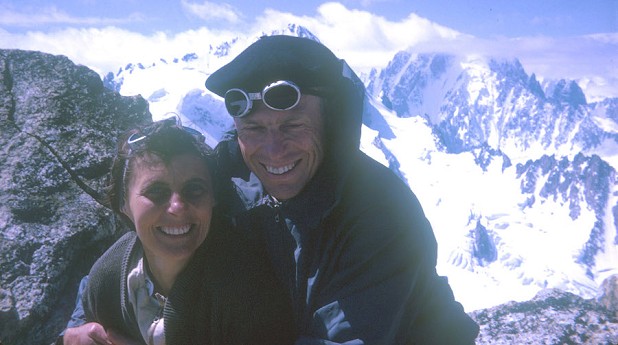
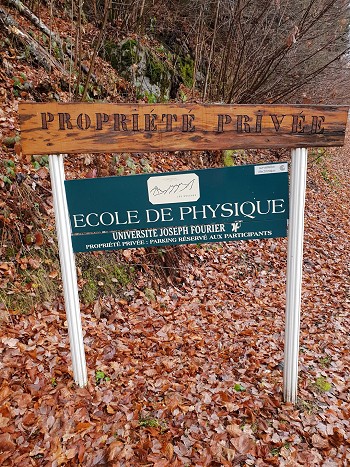
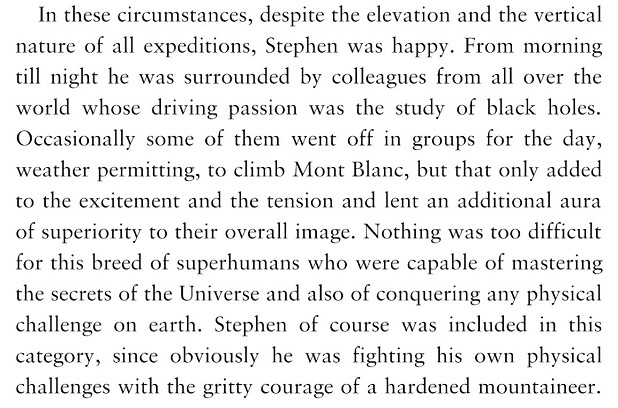

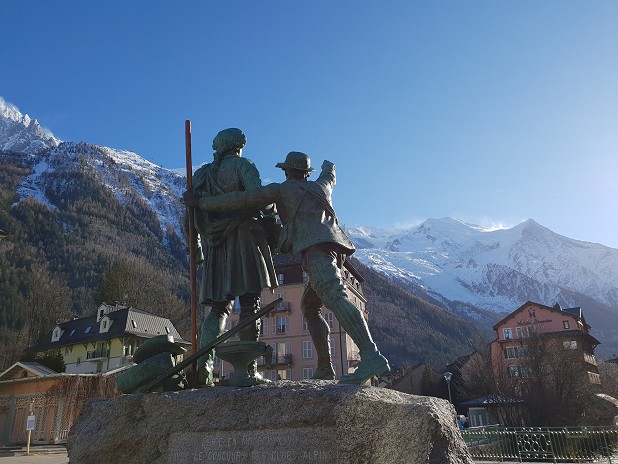
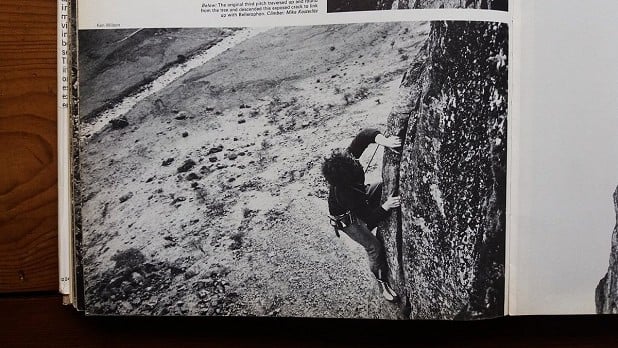
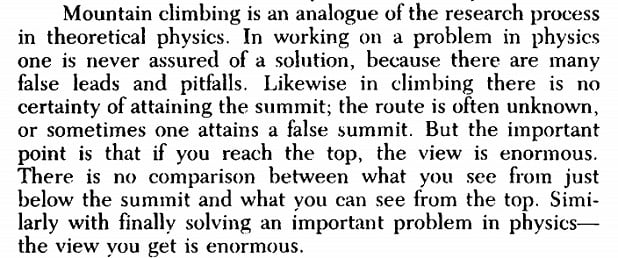
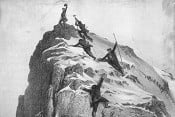
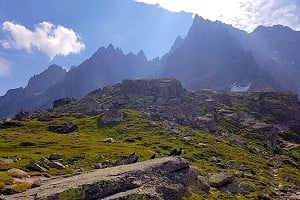
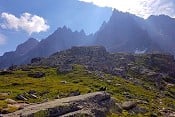
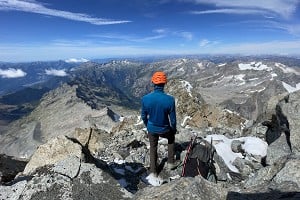
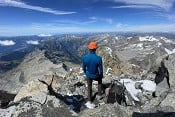




Comments